NMR Data Acquisition The process of data acquisition results in an ...
NMR Data Acquisition The process of data acquisition results in an ...
NMR Data Acquisition The process of data acquisition results in an ...
Create successful ePaper yourself
Turn your PDF publications into a flip-book with our unique Google optimized e-Paper software.
<strong>of</strong> nucleus <strong>in</strong> the molecule (e.g., the CH 3 , CH 2 <strong>an</strong>d OH protons <strong>in</strong> eth<strong>an</strong>ol) has its own reson<strong>an</strong>t<br />
frequency, so the FID consists <strong>of</strong> a superposition <strong>of</strong> a number <strong>of</strong> pure frequencies, correspond<strong>in</strong>g<br />
to a number <strong>of</strong> peaks <strong>in</strong> the spectrum. All <strong>of</strong> the <strong>in</strong>formation <strong>of</strong> the <strong>NMR</strong> spectrum is conta<strong>in</strong>ed<br />
<strong>in</strong> the FID, <strong>an</strong>d a large part <strong>of</strong> the spectrometer is devoted to amplify<strong>in</strong>g, record<strong>in</strong>g <strong>an</strong>d <strong>an</strong>alyz<strong>in</strong>g<br />
this signal.<br />
4. <strong>The</strong> Receiver amplifies the radio frequency FID signal com<strong>in</strong>g from the probe,<br />
converts it to <strong>an</strong> audio frequency signal by subtract<strong>in</strong>g out the radio frequency at the center <strong>of</strong> the<br />
spectral w<strong>in</strong>dow, amplifies it some more, <strong>an</strong>d then converts it to a list <strong>of</strong> numbers. <strong>The</strong> total<br />
amplification given to the FID <strong>in</strong> the receiver is called the Receiver Ga<strong>in</strong> (Vari<strong>an</strong>: GAIN or<br />
Bruker: RG). <strong>The</strong> <strong>in</strong>tensity <strong>of</strong> the FID signal <strong>in</strong>duced <strong>in</strong> the probe coil depends on the sample<br />
concentration, so the amount <strong>of</strong> ga<strong>in</strong> or amplification <strong>in</strong> the receiver must be adjusted for each<br />
new sample. <strong>The</strong> audio signal com<strong>in</strong>g <strong>in</strong>to the digitization stage (the <strong>an</strong>alog-to-digital converter<br />
or ADC) should ideally be <strong>of</strong> the same magnitude for all samples, regardless <strong>of</strong> concentration.<br />
<strong>The</strong> ADC has a maximum r<strong>an</strong>ge <strong>of</strong> <strong>in</strong>teger values that it c<strong>an</strong> give to the signal as it comes <strong>in</strong>,<br />
usually -32,767 to 32,768 (Fig. 8). If the signal is amplified too little before digitization,<br />
the<br />
Figure 8. <strong>The</strong> ADC ("digitizer") c<strong>an</strong> be<br />
viewed as a ladder <strong>of</strong> possible numerical<br />
values. In the figure <strong>in</strong>teger values <strong>of</strong> -<br />
13 to +13 are shown, but <strong>in</strong> reality the<br />
r<strong>an</strong>ge is usually more like -32767 to<br />
+32768. If the ga<strong>in</strong> is set too high, the<br />
first portion <strong>of</strong> the FID has <strong>an</strong> <strong>an</strong>alog<br />
voltage higher th<strong>an</strong> the maximum <strong>of</strong> the<br />
digitizer, so these values are "clipped" at<br />
the maximum value. This will lead to<br />
large basel<strong>in</strong>e rolls <strong>in</strong> the spectrum. <strong>The</strong><br />
optimal ga<strong>in</strong> just fills the digitizer with<br />
signal without exceed<strong>in</strong>g the limits. If<br />
the ga<strong>in</strong> is set too low, the shape <strong>of</strong> the<br />
signal is lost <strong>an</strong>d a “blocky”<br />
representation <strong>results</strong>. This reduces<br />
signal-to-noise ratio <strong>an</strong>d dynamic r<strong>an</strong>ge.<br />
numbers will get "gra<strong>in</strong>y": they<br />
might r<strong>an</strong>ge from -7 to +8 with<br />
only 16 possible values. In this<br />
case it would be very difficult to<br />
f<strong>in</strong>d a small peak <strong>in</strong> the spectrum<br />
<strong>in</strong> the presence <strong>of</strong> big ones (<strong>in</strong><br />
f<strong>an</strong>cy l<strong>in</strong>go, this is called a<br />
"dynamic r<strong>an</strong>ge" limitation). If, on the other h<strong>an</strong>d, if the signal is amplified too much, it might<br />
exceed the digitizer limits <strong>an</strong>d get truncated or "cut <strong>of</strong>f". For example, a signal which would give<br />
a value <strong>of</strong> 52,314 would be read as 32,768 because the digitizer c<strong>an</strong>'t respond to <strong>an</strong>y larger value.<br />
This cutt<strong>in</strong>g <strong>of</strong>f or "clipp<strong>in</strong>g" has very drastic effects on the spectrum: the basel<strong>in</strong>e gets huge<br />
23



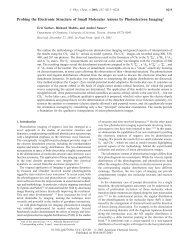

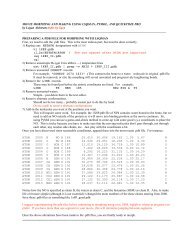


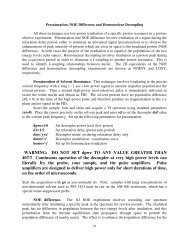


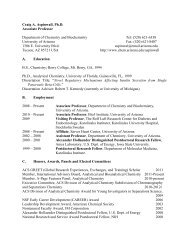
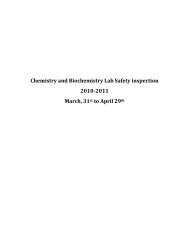
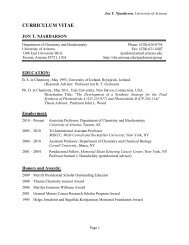
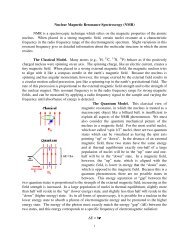
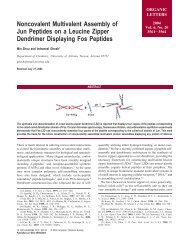
![Program [pdf] - Department of Biochemistry and Molecular ...](https://img.yumpu.com/8309921/1/167x260/program-pdf-department-of-biochemistry-and-molecular-.jpg?quality=85)